GR221 Dry Stone Route – Mallorca September 2022
Posted by Danny Pearson on Jan 25, 2024
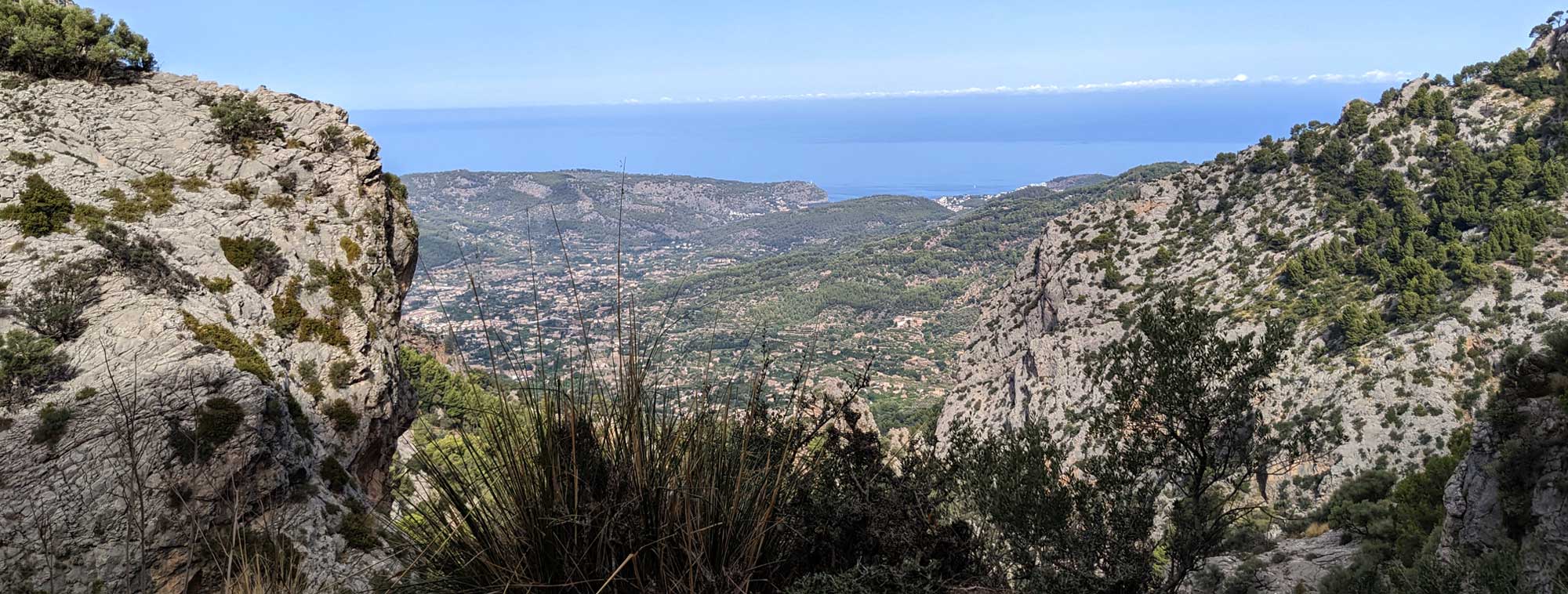
Late in 2021, I decided that with travel opening up I wanted to walk a GR route and having looked at the Cicerone book by Paddy Dillon it seemed to be perfect.
Originally, I was planning to go in late March or Early April 2022 but due to the launch of our new website and a few issues with that (apologies if you experienced any problems when it launched in April 2022) this had to be put back. The earliest realistic time looked to be September when summer temperatures would be beginning to fall, well that’s what I thought anyway.
Getting There
There are loads of UK airports flying to Palma, the capital of Mallorca with a variety of airlines. The one with flights that suited the dates best was from Leeds-Bradford airport, about an hour or so drive away with Ryanair.
Cost - £140 return including taxes and up to 10kg Carry-on bag
For those wondering, I had no problem with my trekking poles in the carry-on. I asked the Ryanair staff on arrival and they checked with security who said it was no problem.
The flight out was late afternoon on Thursday 1st September with a return flight on 10th September late evening to allow for 8 days of walking and a full day to travel back to Palma.
The flight to Palma was late leaving thanks to Ryanair sending a Dublin flights passengers to the Palma plane by mistake making both flights late. Oops!!
Once in Palma, stayed for 1 night at the El Josemari Hostel in the centre which was only a shortish walk to the main bus station. Then got a bus from Palma to the start in Port D’Andratx (which cost only £3) the following morning in time for breakfast and a stop at the local supermarket for a couple of days lunches.
Gear List
- Rucksack: Gossamer Gear Gorilla 50 (Weighs: 858g)
- Sleeping Bag: Sea to Summit Traveller
- Sleeping Liner: Cocoon Silk Travel Sheet - Required for some Refugios (Weighs: 150g)
- Pillow: Nemo Fillo Elite Weighs: 82g
- Hydration System: Hydrapak Hydrasleeve Reservoir 3L (Weighs: 314g)
- Bottle: CNOC Vesica 28mm 1L x 2 (Weighs: 60g each)
- Packing Bags: 2 x Granite Gear Airsack
Clothing
- Waterproof Shell: Montbell Versalite Jacket (Weighs: 192g)
- Shorts: Mammut Runbold Shorts (Weighs: 190g)
- Trousers/Pants: Mammut Runbold Pants (Weighs: 251g)
- Shirt: Mammut Lenni Short Sleeve Shirt
- Shirt: Mammut Lenni Long Sleeve Shirt
- Baselayer (for sleeping): Patagonia Capilene Cool Daily Short Sleeve Tee (Weighs: 118g)
- Underwear: 2 x Saxx Quest (Weighs: 76g each)
- Socks: 2 x Farm to Feet Damascus Trail 1/4 (Weighs: 48g each)
- Sunglasses: Julbo Renegade M
- Hat: Fjallraven Bucket Hat
Accessories
- 1 x 10,000mAh Power Bank (Weighs: 153g)
- 1 x USB C to USB C cable
- 1 x USB to USB Micro cable
- Garmin Inreach Mini
- Google Pixel 5 loaded with offline maps of Mallorca and GPX of GR221 on Komoot Premium and Mapy.cz
- First Aid Kit
- Suncream
- Wash kit
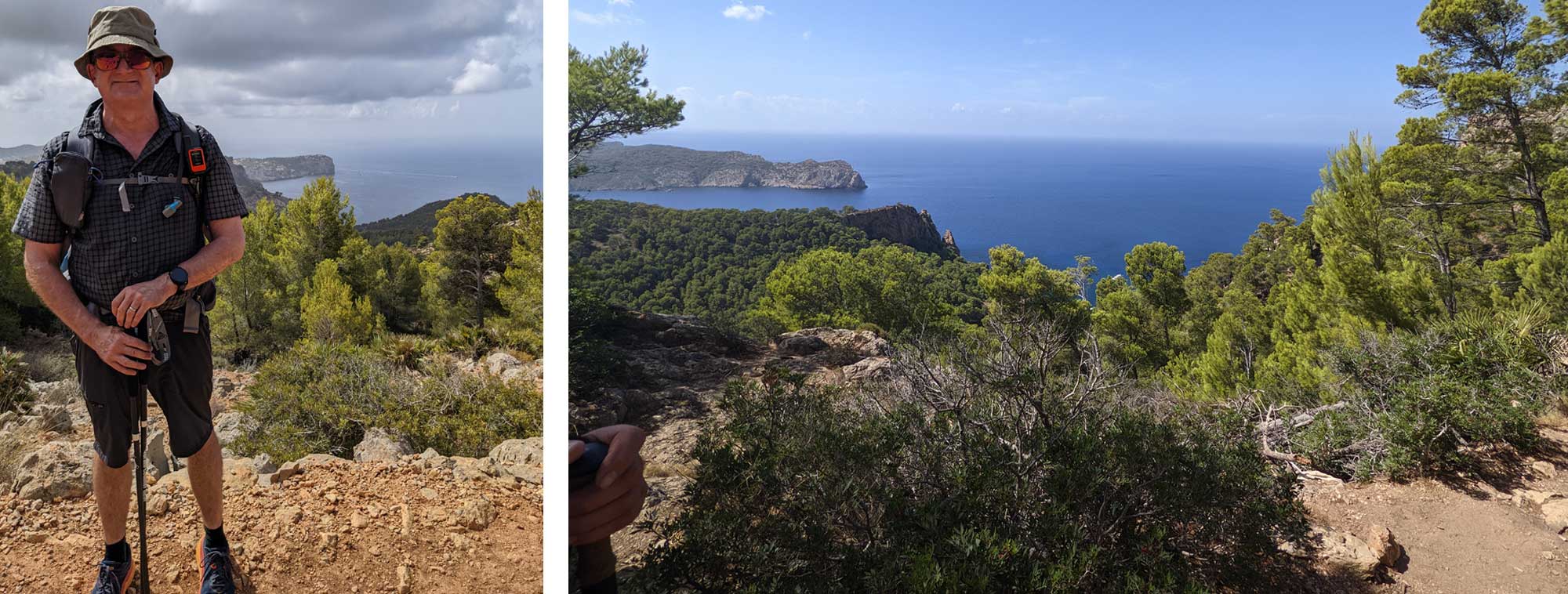
The Route
There are several different versions of the GR221 with multiple possible start points but the route from Port D’Andratx to Pollenca (the longest version) is considered to be the complete route. This was the one we intended to undertake.
It’s illegal to wild camp within the Serra de Tramuntana and having read of several people having issues with the Guardia Civil and police, we decided to stay in hostels and refuges. The availability and location of accommodation dictated the length of the days and where we stopped. We did take sleeping bags just in case we had to cowboy camp at some point!
Day 1 – Port D’Andratx to Ses Fontanelles 22km
Day 2 – Ses Fontanelles to Estellencs 13km
Day 3 – Estellencs to Esporles 15km
Day 4 – Esporles to Deia 20km
Day 5 – Deia to Soller 13.88km
Day 6 – Soller to Tossals Verds 17.5km
Day 7 – Tossals Verds to Lluc 19km
Day 8 – Lluc to Pollenca 18.5km
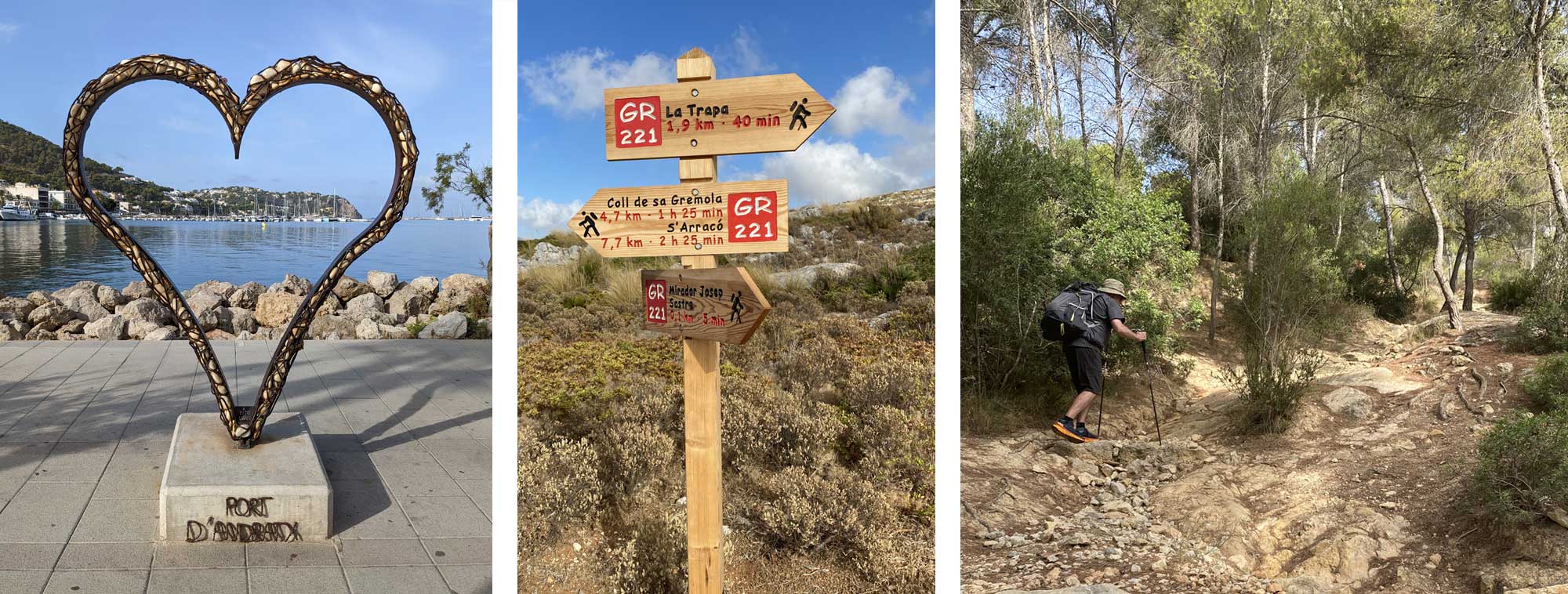
Day 1 – Port D’Andratx to Ses Fontanelles 22km
After breakfast at a harbour side café, we set off. It was still only 9 am but already the temperature was in the 30s. As you leave the town of Port D’Andratx you soon enter a wooded climb with almost no air movement which made it oppressively hot. For two Brits who had only just arrived on the island the night before it felt unbelievably hot.
The path to Sant Elm was for the most part a broad track although due to the lack of signage, we had to keep checking our location using GPS. We met 2 lads from Teesside who were also starting on the same day and live less than 10 miles from Ultralight! Small world.
At several points there were unsigned junctions. After a few wrong turns we reached Sant Elm at lunchtime. We bought some more big bottles of water and refilled our water, as during the short walk to Sant Elm we had got through a surprising amount of water due to the high temperatures.
The path climbed up through an old forest and the ground became rocky and rooted as we ascended. There were a few scrambly sections, one with a rope for security. Eventually the path became easier as it approached La Trapa. At this point, my friend realised that his full water bottle must have fallen from his pack during the scrambles.
He went hunting for water at La Trappa and as luck would have it there was an old guy there in his 70’s who looked after the old monastery site. He had just carried 10 litres of water to the ruins in advance of an event and kindly donated some! What a legend.
The track then climbed away from La Trappa and eventually levelled and the walking was easier. We started to cover the ground more quickly but were both struggling with the heat. There was no shade to be found anywhere.
The final few kilometres were on vehicle tracks and then a road walk to Ses Fontanelles. It was uneventful.
When we eventually reached Ses Fontanelles we were ready to stop. The heat had been unbelievable, in excess of 40C in the shade and there was little shade to be found for long sections of the route so the temperatures in full sun were considerably more.
There is a bunk house at Ses Fontanelles but we had been unable to reach the owner by email or phone so had been forced to book the Finca B&B through Booking.com. The upside of this was that we had arranged for a cooked dinner which was excellent and washed down with a couple of cold beers.

Day 2 – Ses Fontanelles to Estellencs 13km
The following morning, we had expected breakfast to be available but the owner wanted to go shopping and left us without even a coffee. Fortunately, we had some food left from the previous day so we didn’t set off on empty stomachs but it was disappointing.
We had read stories on the GR221 about him being a bit unpredictable and he certainly lived up to that. A group of walkers passed through the finca as we were getting ready to set off and he was quite rude to them. At this time the GR221 was actually signed through Ses Fontanelles but has subsequently been re-routed as he no longer allows anyone to pass through. This was the only place to purchase water between Saint Elm and Estellencs and the owner no longer does that which could be an issue for some walkers in high temperatures unless they stay at the finca or bunkhouse.
At that time the GR221 passed through Ses Fontanelles and the owner put out bottles of water for walkers to buy. Recently I have read that he no longer allows people walking the GR221 to pass through the property and there is no longer water for sale unless you are staying at the Finca. This would mean in Summer there could be a real problem for people walking the route.
The path climbed through a narrow-wooded valley and despite being only 9 am it was already getting hot. A rough path then ascended steeply out of the valley and became increasingly tricky to follow. There were occasional cairns to mark the way but they were surprisingly easy to miss.
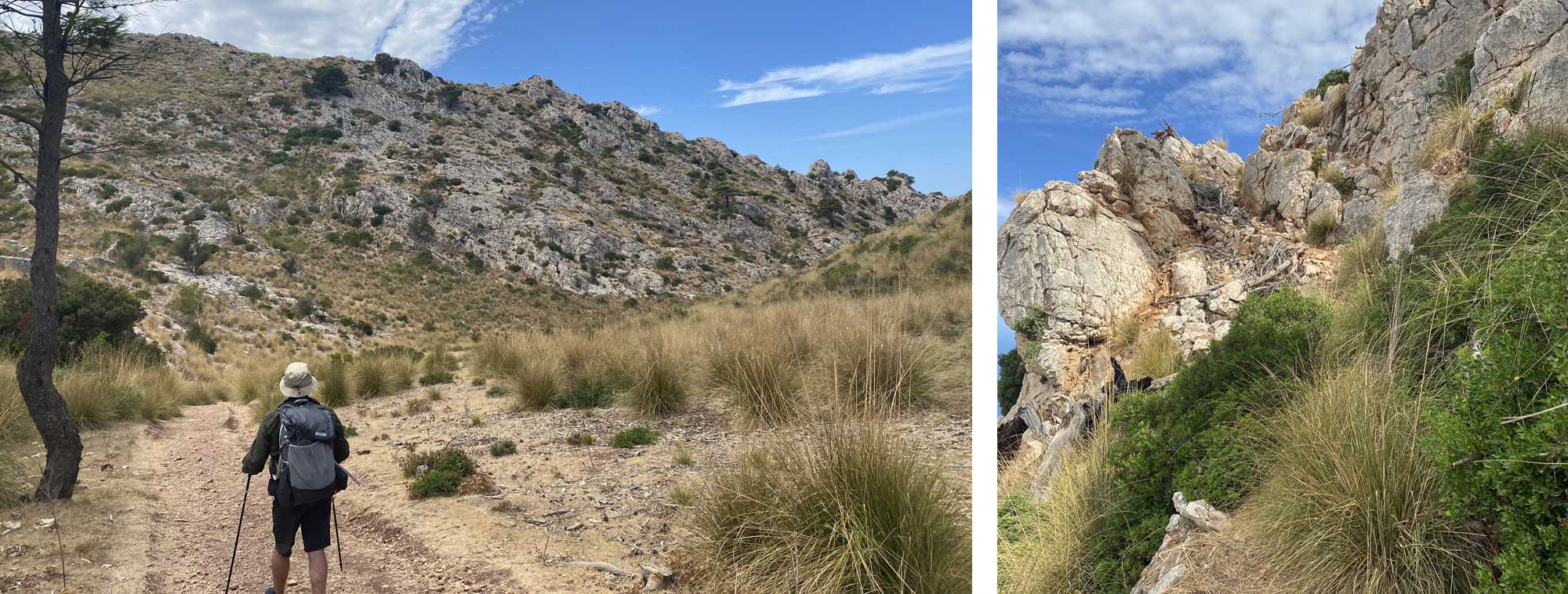
After clearing a gap in the cliffs, the ground opened out onto a rocky moonscape dotted with pines. Navigation was reliant on following small cairns which often disappeared so we did have to resort to GPS a couple of times to keep on track.
It was proper ankle-breaking ground with big rocks scattered across the mountain top with treacherous gaps between them, reminiscent of some Cairngorms routes.
The route was continuously uphill to around 850m with very little shade and full sun on rocky ground. We were still not acclimatised to the heat, so different to the North East of England.
There were stunning views from the path and out across the Med. Eventually, the path did start to descend amongst pine woodland and then the holms oaks that are so common in Mallorca. Eventually we met the road and a track running alongside it and then turned off down a zig-zagged lane to our overnight stop in Estellencs. There are no hostels or bunkhouses here so this was our night of comfort at Hotel Maristel.
On paper this was a relatively short day but the rocky ground and heat made it feel much longer. We did get to enjoy an excellent dinner on the roof terrace enjoying the views and the wonderful sunset.

Day 3 Estellencs to Esporles 15km
There was a bit of road walking for the first few kilometres of the day before climbing on a rocky path around the Puig de na Foradada.
There are so many terraces growing olives and carob in this area and much of the walking was on easy paths along the terraces.
We arrived in the pretty village of Banyalbufar which sits on the side of a steep slope in time for lunch. Lunch was at the Café Bella Vista with a fantastic terrace looking out across the bay.
You leave Banyalbufar up a steep road past terraces of fruit trees and olive groves. The road turned from tarmac to a stony track to climb relentlessly. Again, there was little shade and it was very hot climbing back up into the mountains.
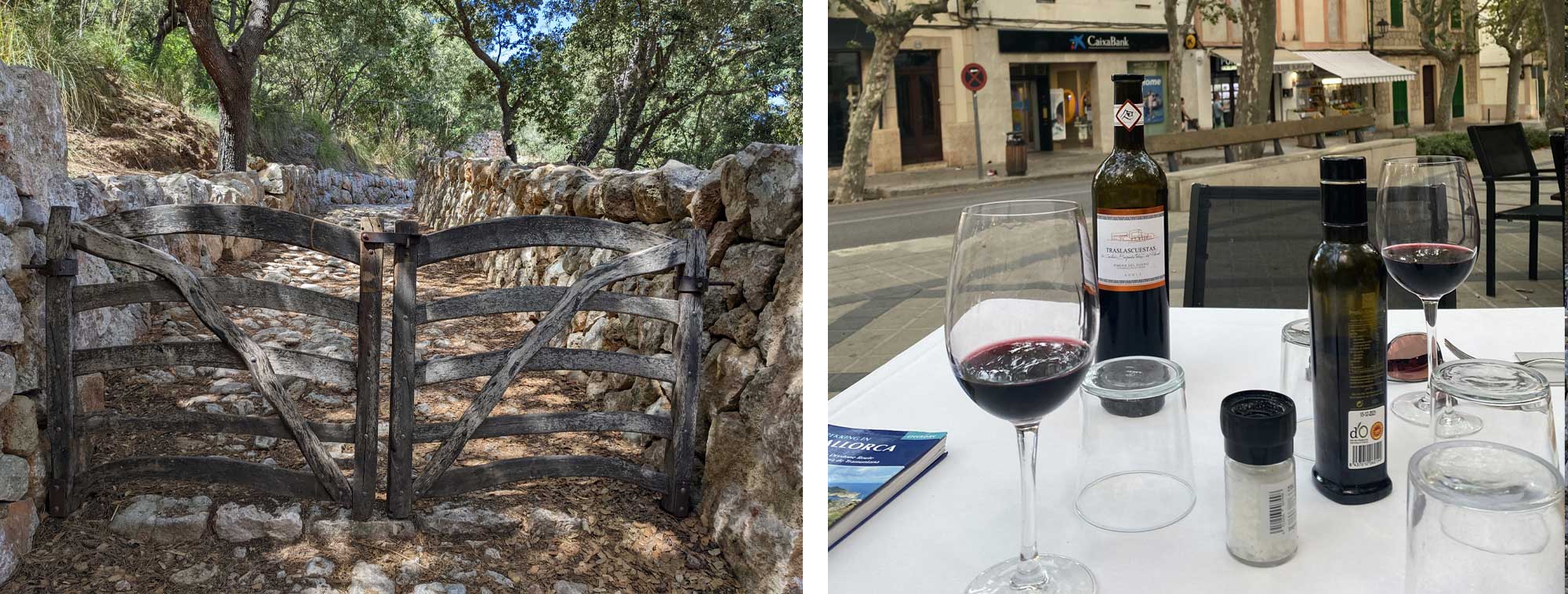
Some of the tracks on the way to Esporles are clearly ancient and in places the original surface paved with boulders survives. Largely easy walking apart from the ever-present heat. This route is known as the Post Path and was really impressive, with solid walls enclosing the trackway. After the brutal climb in the sun, the path became easier and there was some shade from the holm oaks lining the path. The track zig-zags on a rocky surface towards the town of Esporles.
Esporles has an attractive wide main street lined with bars and restaurants unlike the hillside villages we had visited along the route. We were staying in a bunkroom at the Sa Fita Backpackers hostel in the town and after freshening up headed out for something to eat at one of the many restaurants.
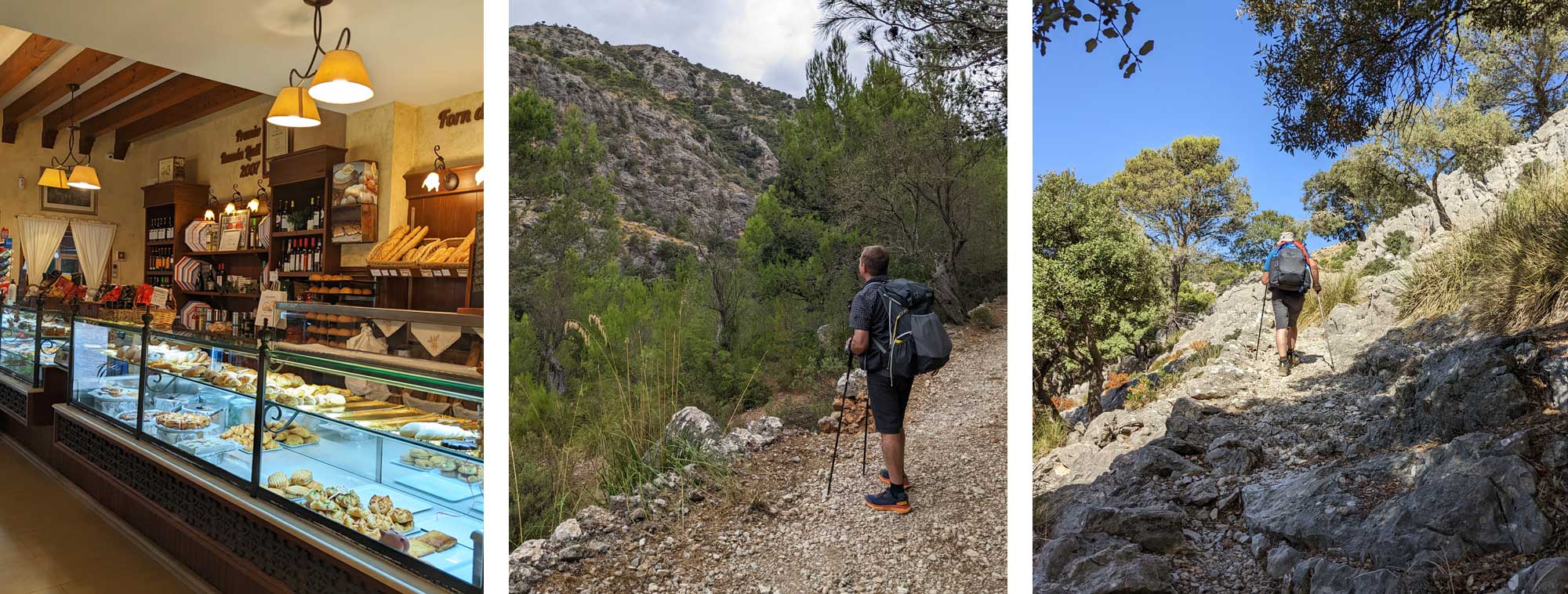
Day 4 Esporles (Valldemossa) to Deia 20km
There are currently some access issues on the GR221 between Esporles and Valldemossa due to a land dispute and access problems. We decided to skip this section for this reason and booked a taxi from Esporles to Valldemossa.
We arrived for breakfast in Valldermosa, at the famous Mallorcan bakery, Forn i Pastisseria Ca'n Molinas where we enjoyed a local dish of sliced tomatoes, basil and olive oil on toasted bread. Delicious. Worth a visit just to look at the amazing cakes and pies on offer!
The route climbed away from Valldemossa in a forested valley on a mostly concrete track. Although it was steep there was plenty of shade and the surface made for easy walking. Eventually we reached the Refugi de Son Moragues which is no longer open but was somewhere to sit in the shade and rest our legs for a while.
At the top of the climb, the path became narrower and becomes the Cami de s’Arxiduc (Archduke’s Path). An amazing carriageway built for the Archduke for his own amusement to be driven across the top of the mountain in his carriage, crazy!
At the summit the views across the Mediterranean from Puig Gros 938m were stunning. You could see for miles along the coast but also back over the Tramuntana mountains behind.
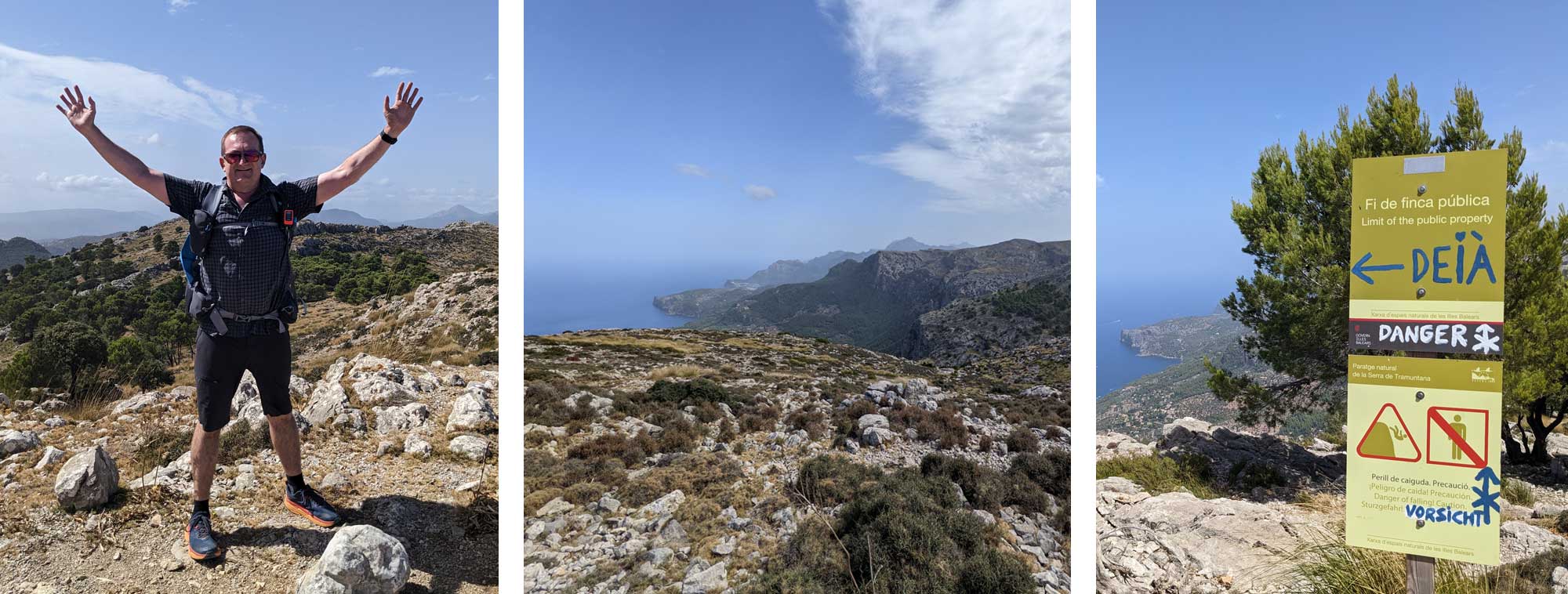
The track eventually reaches the cliffs and descends on a steep and loose path zig-zagging towards Deia. The surface was loose with marble-like stones and leaves from the holm oaks. I took a heavy fall when my feet disappeared out from underneath me on the loose surface. Fortunately, I landed on my back and the rucksack took the brunt of it.
The finish for the day was at the excellent Refugio de Can Boi. The Refugio’s are incredibly well priced and also provide a decent dinner for very little cost.
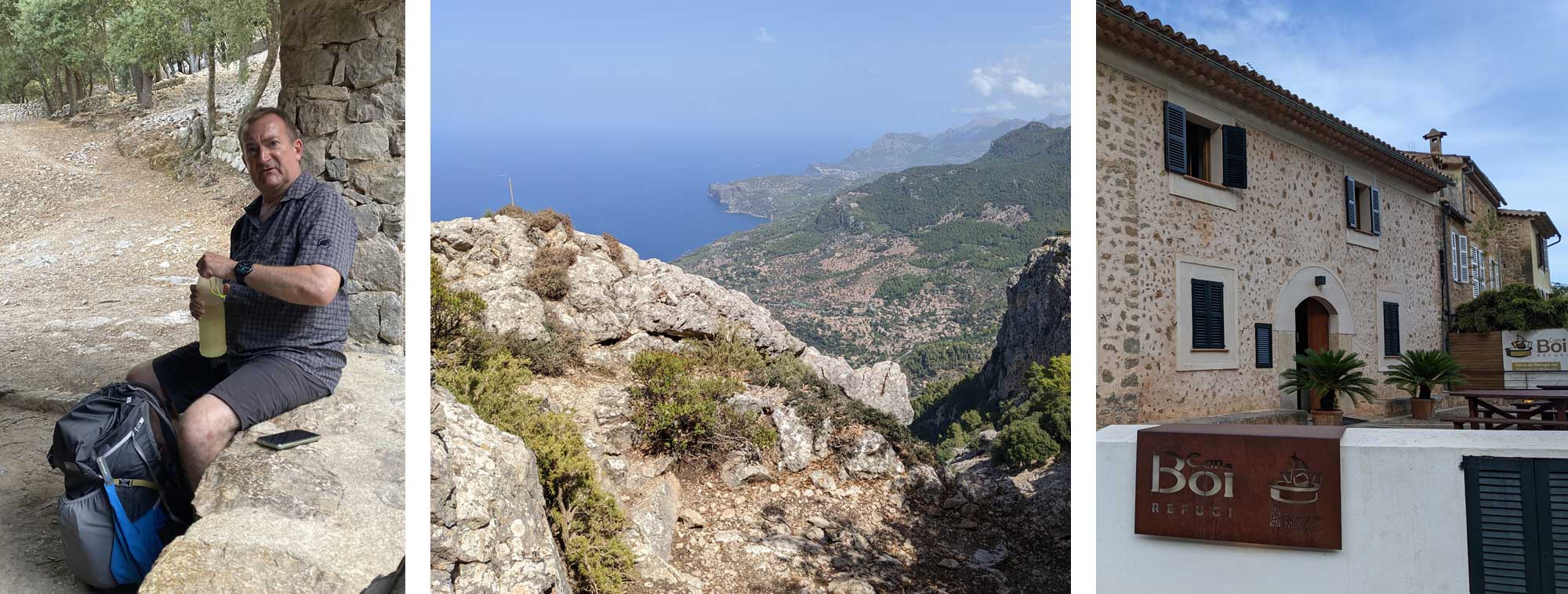
Day 5 Deia to Soller 14km
This was a straightforward day but was again incredibly hot. The route started on the road before climbing on a path past a number of isolated houses on the hillside. The walking was pretty straightforward on hard tracks and easy paths.
Soon we reached the impressive house at Son Mico which also offers refreshments from its café. There was a selection of cakes and freshly pressed orange juice. I’m a sucker for a lemon meringue pie and the one on display looked yummy. A glass of juice and a generous slice of lemon meringue was enjoyed on the large terrace outside the house enjoying the views.
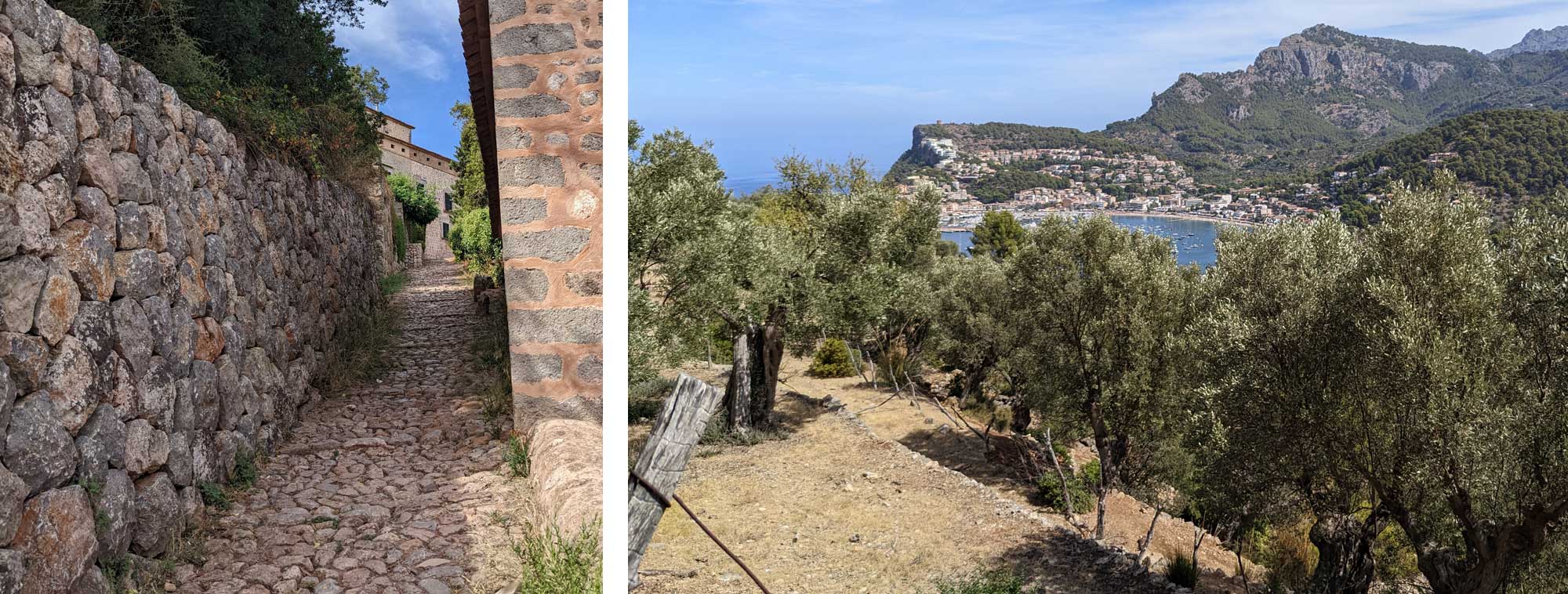
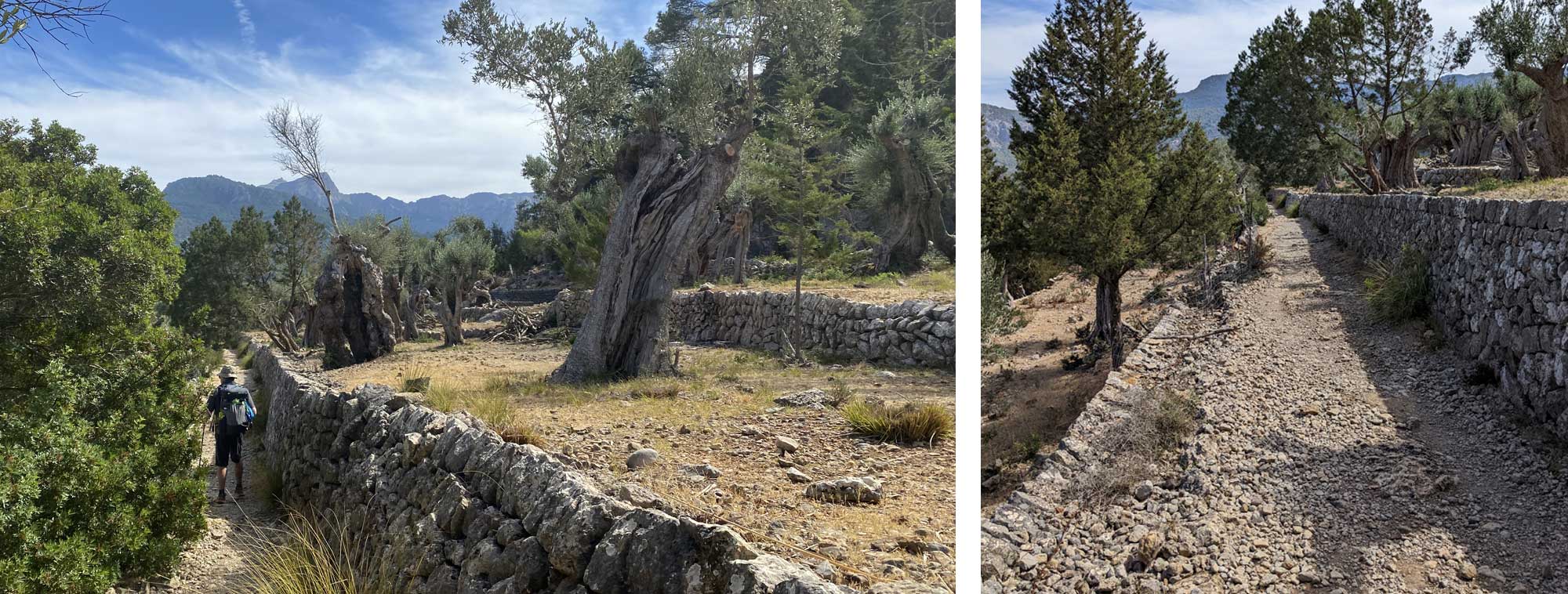
Then we continued on towards Soller. Most of the walking was now on quiet tarmac roads for the next few miles. The problem with tarmac is the heat it gives off once it's warmed by the sun. Tarmac eventually turned into gravel and dirt tracks which were surprisingly busy with construction lorries kicking up loads of dust. The dirt track then finished at a narrow stone path that carried us on towards Soller. It was pretty easy going but the days of walking in full sun were starting to catch up with me. I’d been fine for the first few days but as the day went on, I was starting to struggle with the heat. As we dropped onto another tarmac lane to Soller I had to stop in the shade a few times because I felt that I wasn’t coping too well with the heat.
We arrived in Soller early in the afternoon and stopped at the first bar we saw to rehydrate!
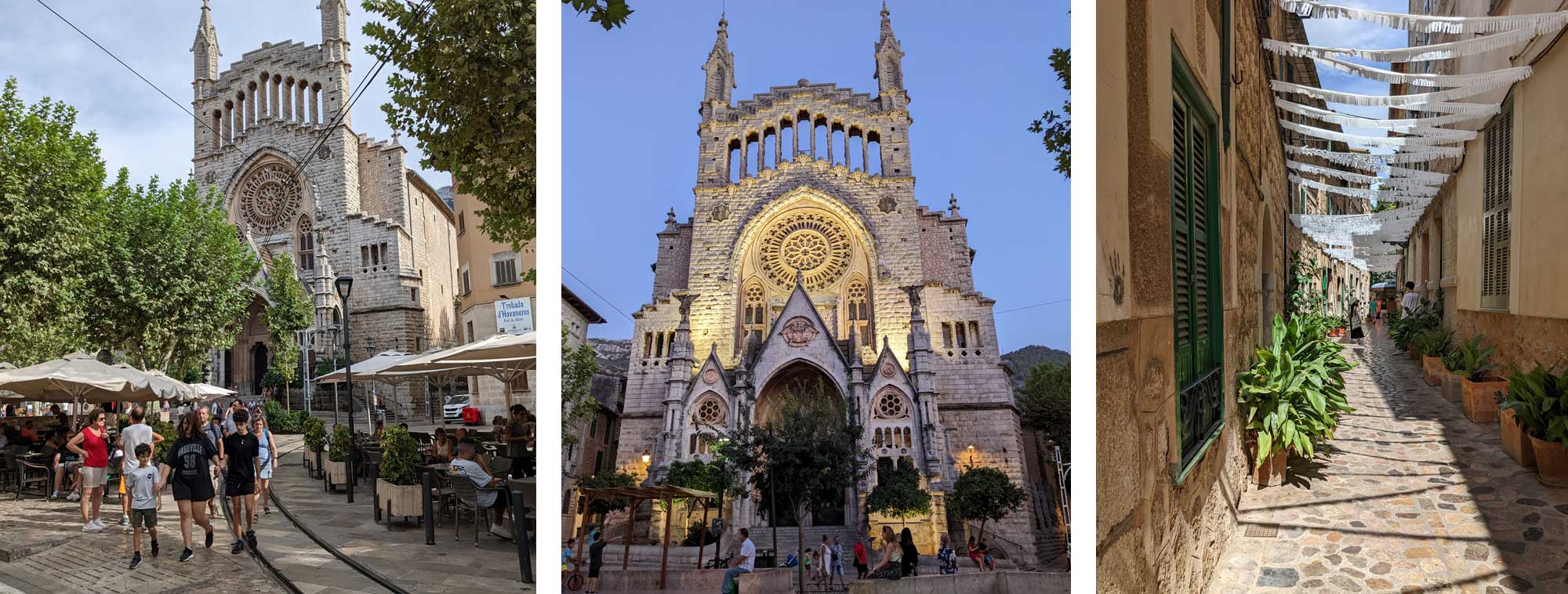
Then on to the very reasonably priced Hostel Nadal that we had booked for the night. A private twin room but with shared facilities. After a couple of hours to relax, we headed out to look around the town and get some dinner. You can’t come to Mallorca and not have a classic Paella which was excellent at a restaurant on the busy central square in the town. Then early to bed, we planned to leave extremely early to try and beat the heat for the climb into the mountains.
Day 6 Soller to Tossals Verds
What a day this would turn out to be!
Only 19km on paper but had a fair bit of ascent and the forecast was for more extreme temperatures. We set off from our hotel at 6 am to get as much distance as possible completed before it got too hot. A quick stop at a baker on the central square for a coffee, bottles of water and some pastries.
After a couple of miles of walking on quiet lanes, we reached the pretty village of Biniaraix. From here the path starts for the climb up the Barranc de Biniaraix, on a stunning zig-zagging cobbled path up the gorge. We crossed several footbridges and stepping stones but the stream was completely dry. The track follows numerous terraces of olives and carob trees.
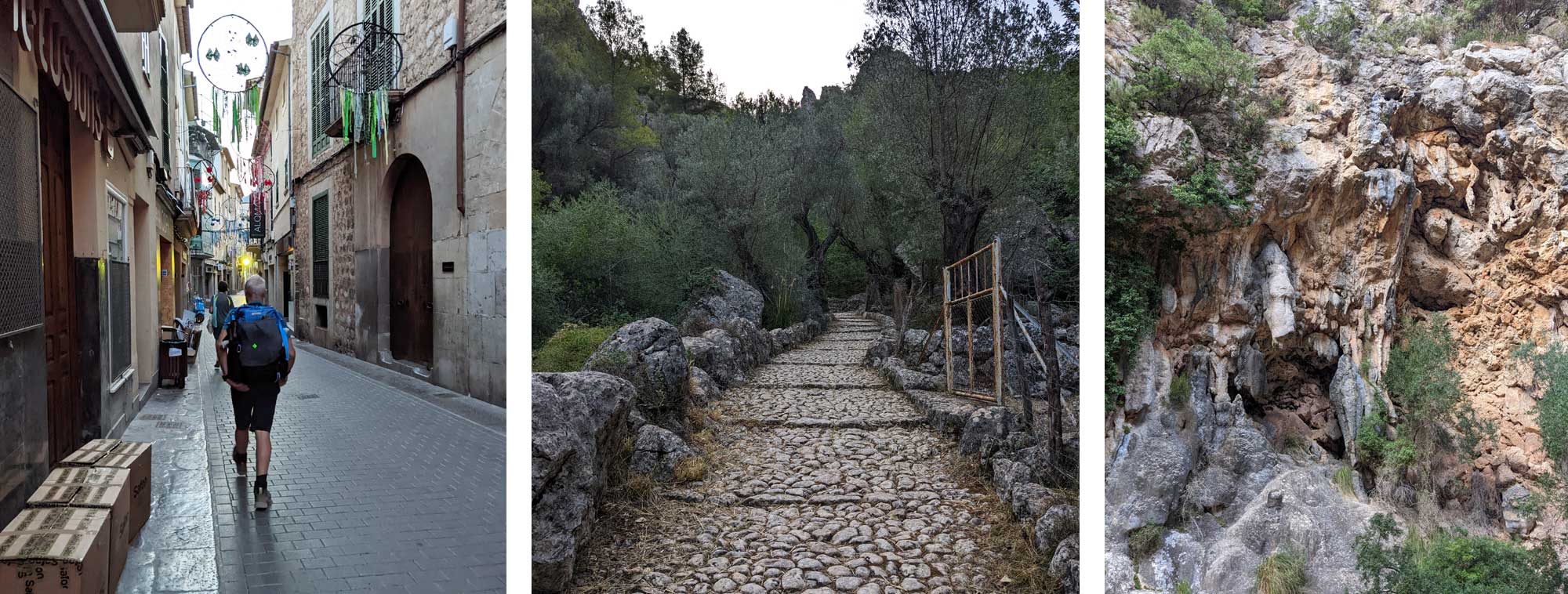
The temperature was rising quickly but fortunately, much of the morning was spent on the shaded climb. Once at the top, it was largely easy walking to reach the Cuber reservoir. The heat of the day was not intense and we lay down in some shade under trees at the head of the Cuber to eat our lunch.
From here there are 2 different routes to get to the refuge at Tossals Verds. We decided to take the slightly shorter but more arduous route which was on narrow, rocky paths in a narrow steeply-sided valley and included a chained section at one point.
The path was rough with constant elevation changes and the sun was reflecting off the white rock sides of the valley. The temperature was getting hotter and hotter, we stopped in the shade whenever there was a tree but mostly there was no shade available. I have no idea how hot it actually got but the forecast was for the high 30s in the shade and we were in a narrow valley that was reflecting the heat and funnelling it down onto us.
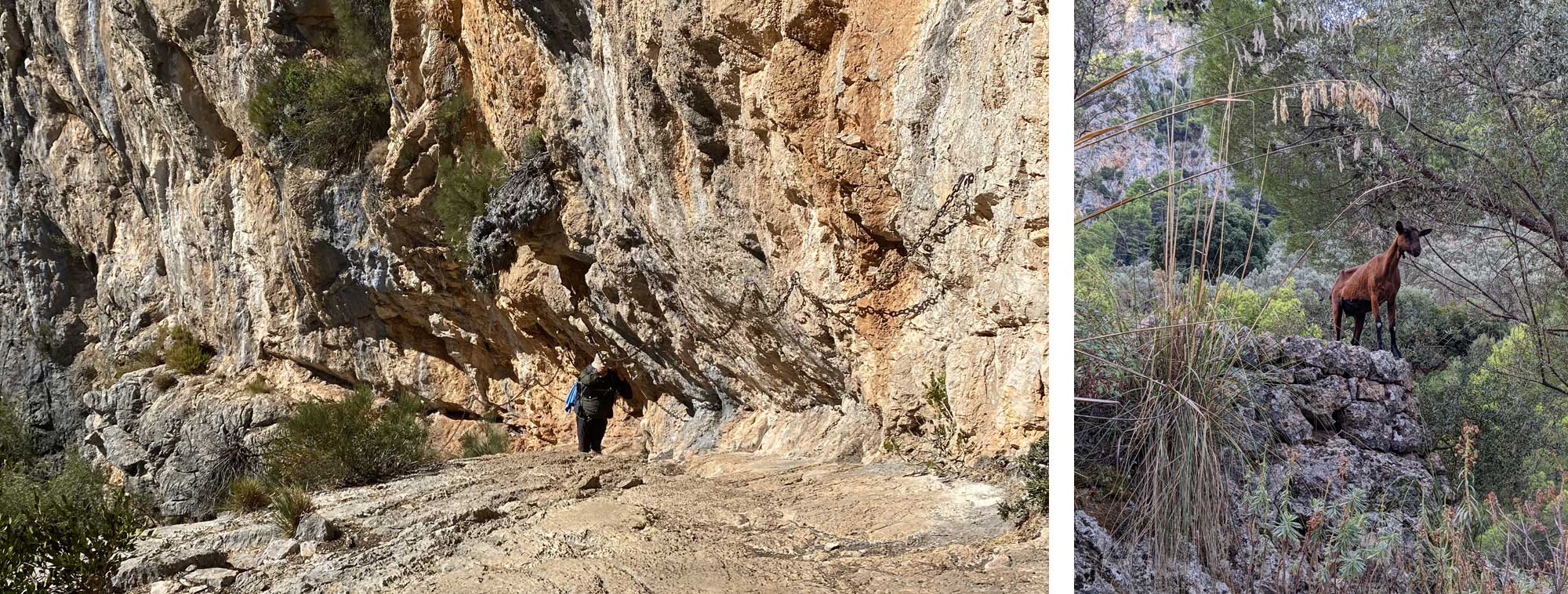
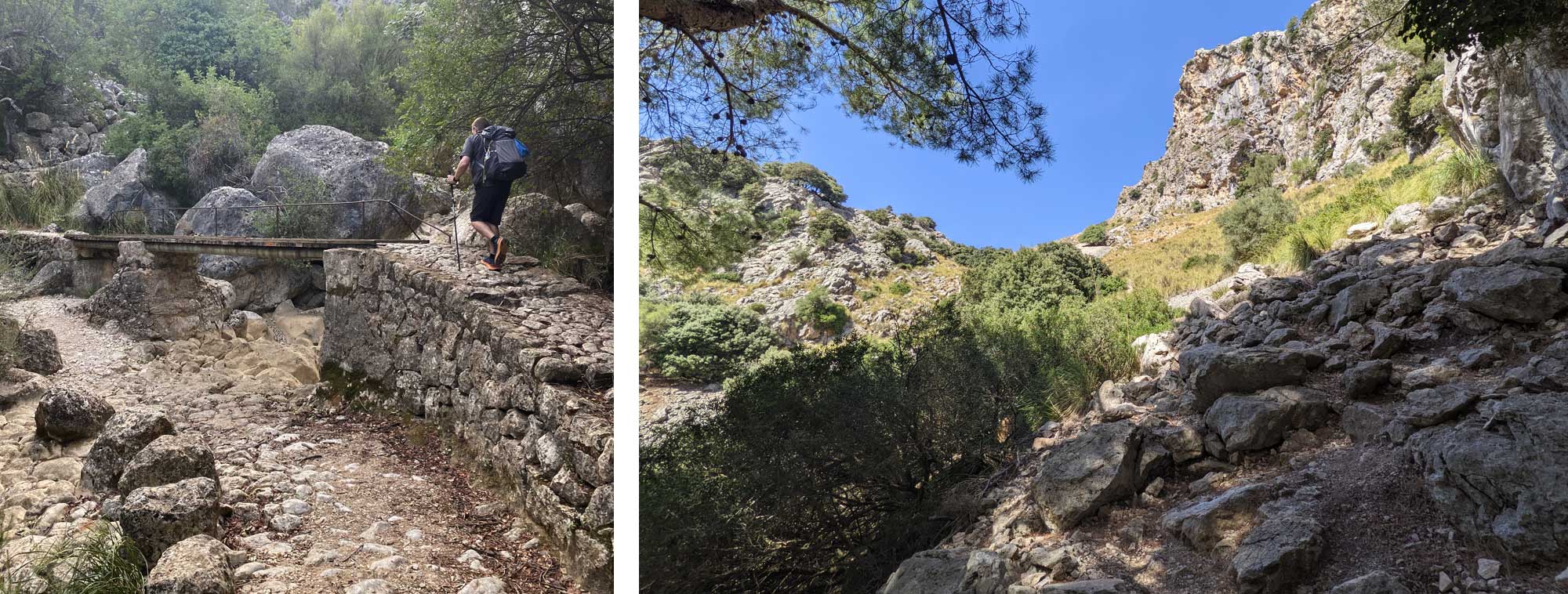
The first I was aware that something was wrong was when I stopped sweating. Crazy temperatures but I wasn’t sweating. My skin felt like it was on fire and I could feel my body getting hotter. The more water I drank, the more I just needed to go to the toilet, it was very strange.
My mind was clearly not functioning properly because instead of sitting down in the shade for as long as necessary I was walking faster and faster to try to get to the finish as quickly as possible. I started to become increasingly unsteady on my feet and was stumbling along. At this point, I ran out of water despite having carried over 5 litres of water with me that day.
After cresting the summit out of the valley, I started to hallucinate and my friend says I was talking total nonsense (it must have been bad for him to notice the difference from normal). My legs turned to jelly and I started to fall over every few steps and soon I didn’t even have the strength to pick myself back up. I was lying on the floor emptying the kit out of my bag to make it lighter to carry on! I thought that I could see people at the refuge across the valley. Neither existed and were just hallucinations it was apparently just an empty hillside. I’ve seen many a movie where someone thinks that they can see an oasis in the desert. Well, it really does happen like that!
My body couldn’t cope with the heat anymore and was shutting down. At this point, I decided to press the button on my Garmin tracker.
My friend also ran out of water at this point but was feeling much better so he continued to Tossals Verds refuge to get water and possibly some help for me. The original Garmin Mini has a very clunky messaging system and I wasn’t with it enough to be able to communicate with Garmin. I did manage to get a 1 bar signal on my phone as there was a break in the mountains and called the police. It was several hours walk from the nearest road so I didn’t have any idea how long any help might be. Garmin had alerted the police to my location and the Guardia Civil had decided to send a helicopter due to the inaccessible location.
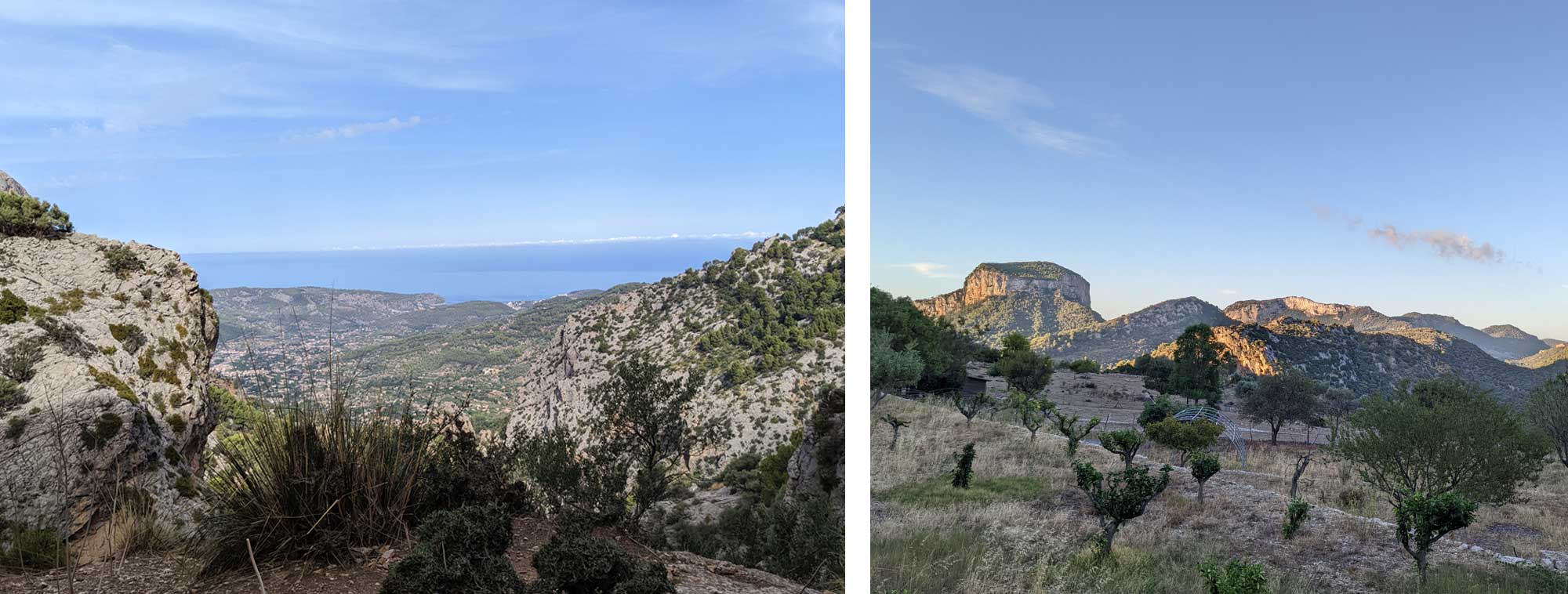
It was around 4.30 pm so the sun was still high but I found a rock crevice out of the sun and managed to crawl into it. I think I must have passed out, when I came around I had no idea how long I had been lying there but probably for no more than 20 minutes. Fortunately, stopping any exertion allowed me to start to cool down. I still wasn’t thinking too clearly and decided to try to continue on to the Refugio. I didn’t get far and after falling over a few more times, stopped in an open area where I would be easier to spot. The sun was dropping over the mountain tops now at least now I wasn't in the sun. I lay down and at some point heard the sound of a helicopter flying down the valley. It landed somewhere in the distance; it was dropping one of their team on the ground in case they needed someone to get to me on foot. Then it lifted off and flew in my direction. It started to look where I had initially triggered the Garmin SOS but I was now a couple of hundred metres from that location after foolishly trying to continue on foot but the decision to stay in the open on flat rock meant that they soon spotted me.
I can honestly say I’ve never been so relieved about anything. I was feeling really poorly and the whole experience had been pretty scary. The sight of the winchman lowering towards me was one that I will never forget. Soon, a Guardia Civil medic had landed next to me and he was very reassuring. A sling was placed around me and up we went into the helicopter as it flew back to the Refugio. We landed there, where I was reunited with my friend and I was checked by the medic. I was pretty embarrassed about having the helicopter out and kept apologising for them having to come.
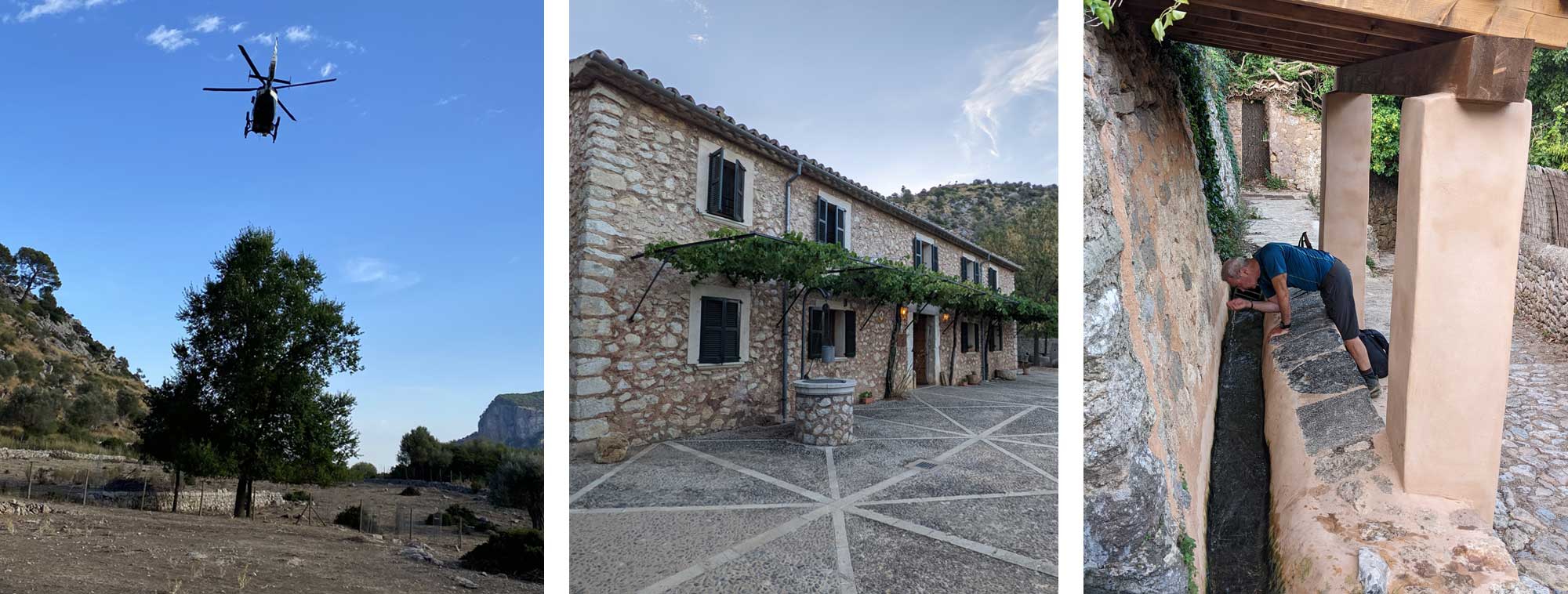
I’m sure in the UK I would have been taken straight to hospital but they asked Carl if he was happy to look at me at the Refugio so they could return to base. They instructed him that I should drink plenty of electrolyte rehydration drinks and get a cool shower. If there were any problems call them and they would come back and take me to the hospital in Palma.
The Refugio had cans of electrolyte hydration drinks so I drank a couple of them and then took a cold shower. I still felt pretty rough so had something to eat and after drinking some more water I went to bed early.
This experience showed the worth of carrying something like the Garmin Inreach Mini. I recommend them to anyone who asks when they see me carrying it now. I plan to upgrade to the Inreach Mini 2 soon, the messaging on the older version is very awkward especially when you are struggling to think clearly. When I was feeling better the next day, I realised I had been messaging my family when I thought I was communicating with Garmin. I wasn’t in a fit state to use the somewhat unintuitive messaging on the older model. Newer versions have a much better phone app for messaging.
Day 7 Tossals Verds to Cuber reservoir bus and on to Sanctuari de Lluc
I woke feeling as though I’d had too much to drink the night before. A terrible headache and was still unsteady on my legs.
There was no chance that I could walk all the way to the monastery at Lluc. Instead, the best option was to walk to the bus stop at Cuber and get a bus to Lluc.
The path was shaded and mostly well-surfaced which made for easy walking. With the benefit of hindsight, it would have been a much better option to take this route the previous day in the intense heat but we weren’t to know that.
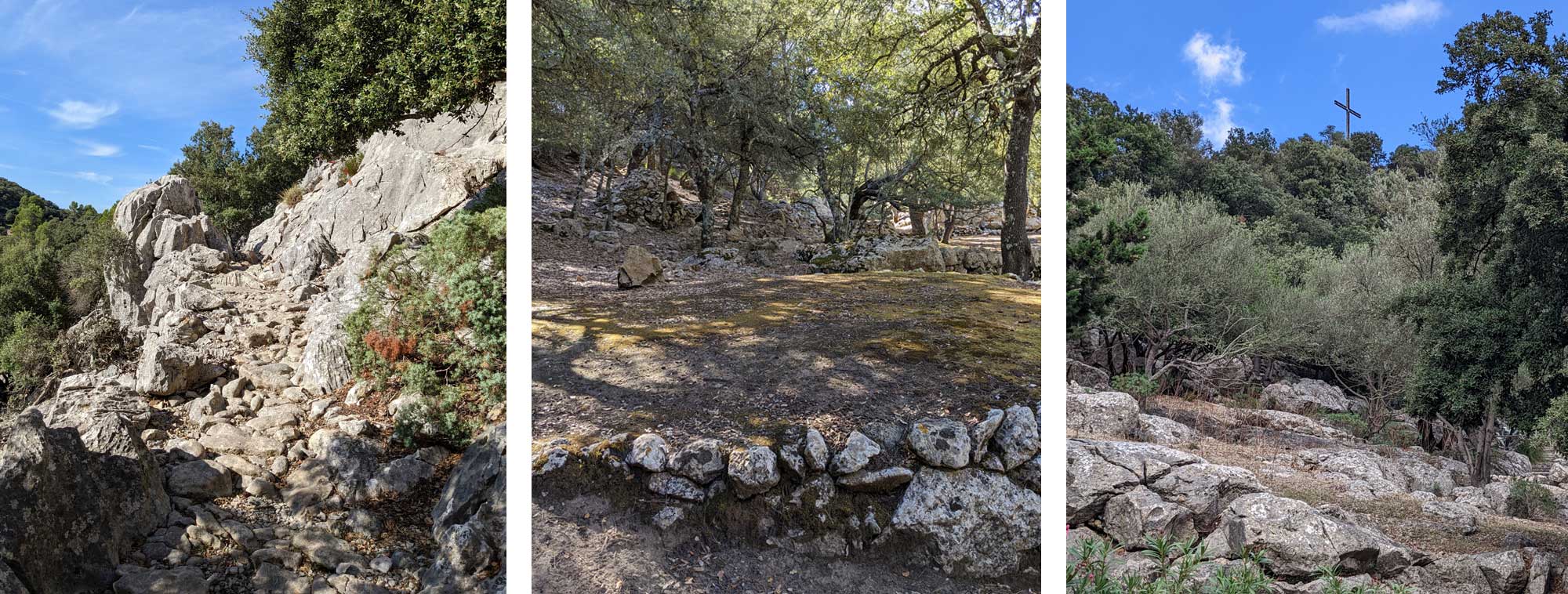
We took our time and the walk was thankfully totally uneventful. When we arrived at Cuber there was a shaded picnic area to eat some lunch and wait for the next bus to Lluc.
The bus ride itself was pretty interesting along a narrow mountain road with a bus driver who clearly didn’t want to wait for anyone. His driving must have terrified the oncoming traffic, he was stopping for no one.
The bus dropped us outside the main entrance to the Sanctuari de Lluc, an impressive monastic site on a grand scale. It’s a big place and still a place of pilgrimage.
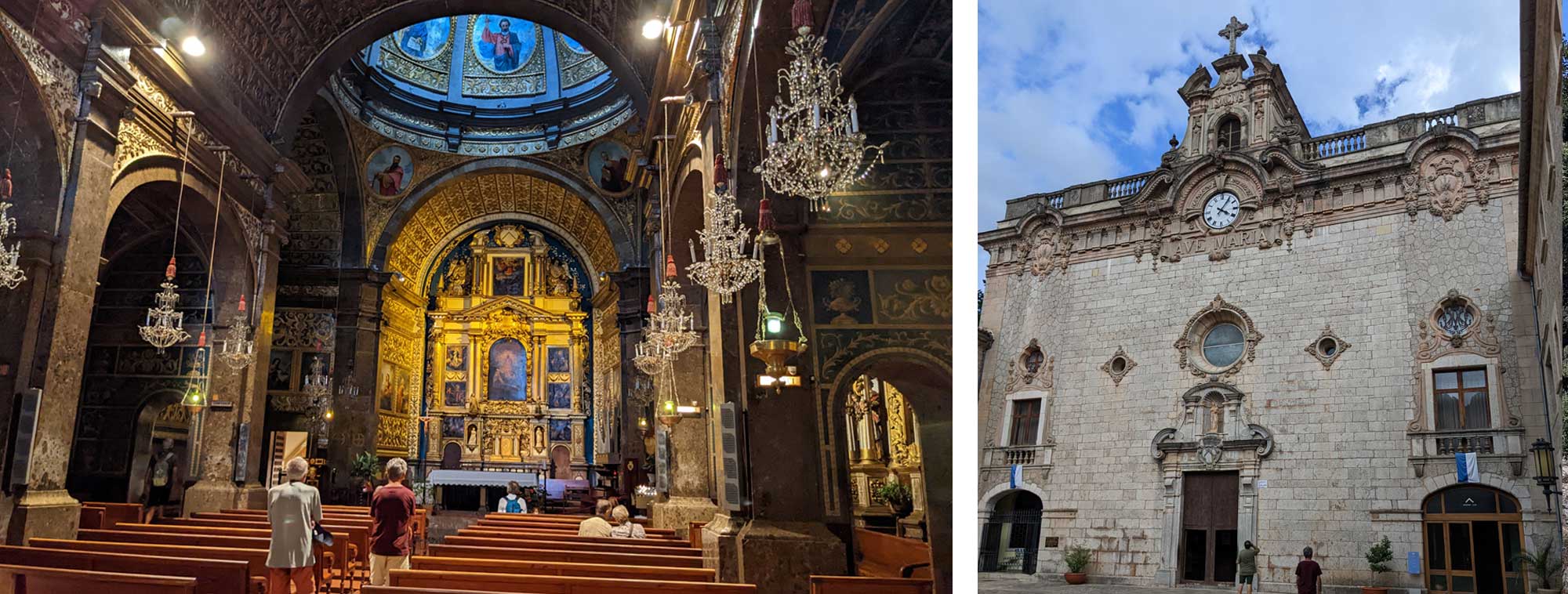
We had booked half-board accommodation at Lluc within the monastery itself which was overlooking an inner courtyard. Once we had washed some clothes and hung them up to dry, we headed out to explore. Dinner was in the extremely grand refectory and was an excellent 3-course meal. Our stay was pretty reasonably priced in amazing surroundings and I would recommend staying there if funds allow – it was £50 each for dinner, bed and breakfast which whilst more expensive than the Refugio’s was still great value.
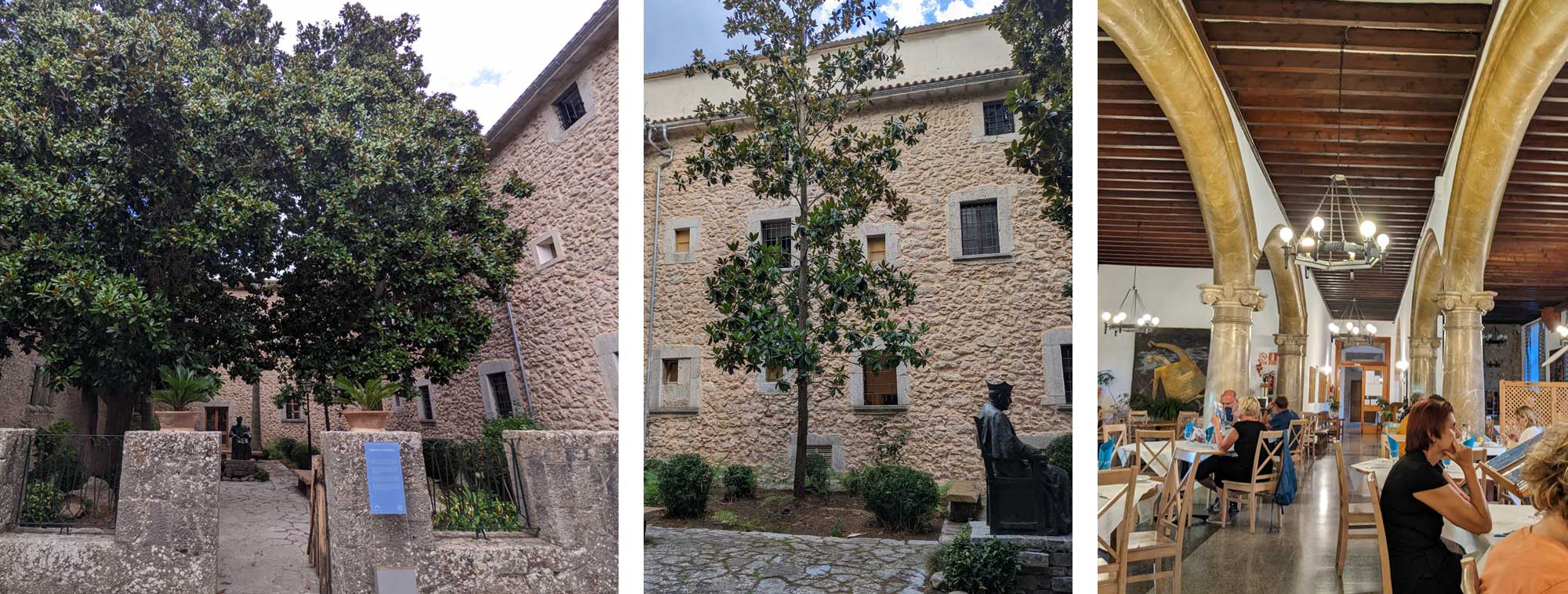
Day 8 Lluc to Pollenca
After taking it easy the previous day, with some good food and an excellent sleep, I was feeling much better when I woke up. Enjoyed breakfast in the stunning refectory and then we set off on our last day. First, we stopped off at the bakers on the Sanctuari square and bought lunch for the day, consisting of a selection of pies and pastries, yummy.
After leaving the monastery site, the path was uphill through woodland to the Refugio at Son Amer which is hidden amongst the trees. It continued uphill for a few kilometres before levelling out, it was largely shaded in the trees which was greatly appreciated. It was a pretty uneventful morning and the track descended downwards before zig-zagging down to a properly surfaced road. Eventually, the road joined the main MA10 highway but there is thankfully a well-surfaced path that runs parallel with the road. A couple of km from Pollenca a small road forks off to the right which would take us directly to our accommodation for the night at the Refugi del Pont Roma. Named after the amazing Roman bridge over the river (which was completely dry on our visit) which is only a short distance away.
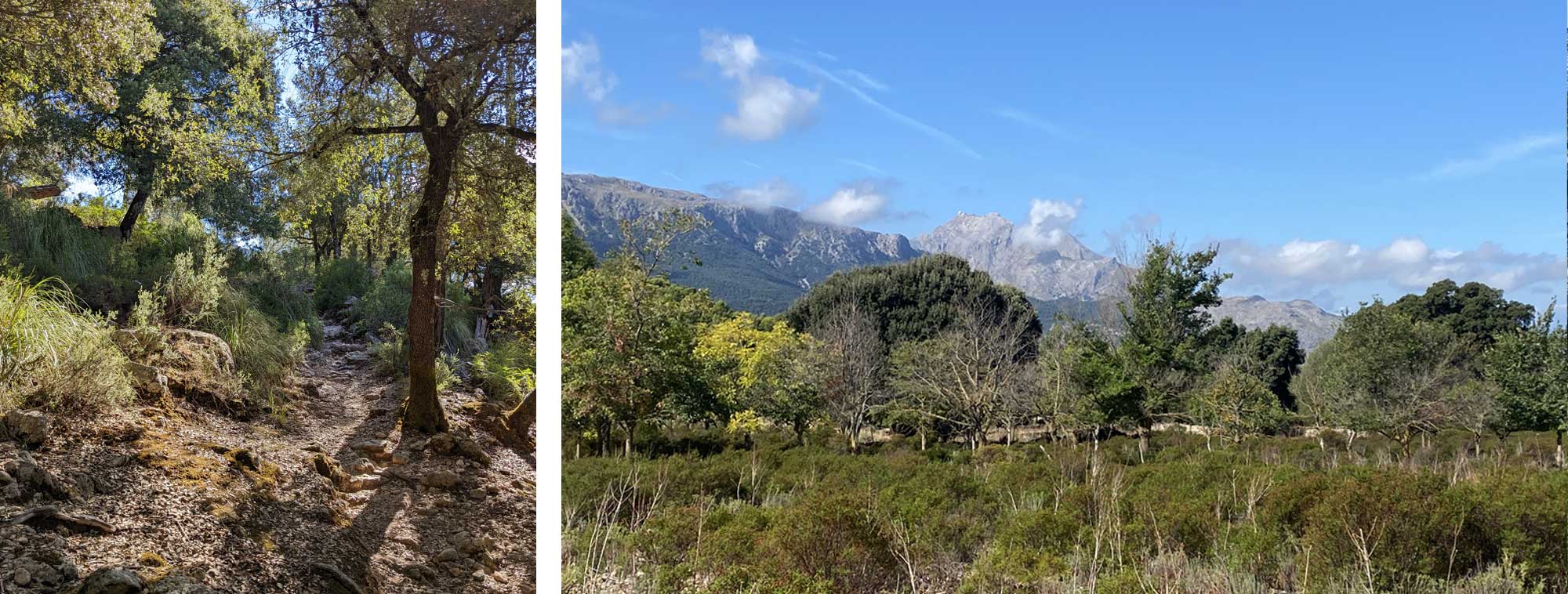
On arriving it was only early afternoon so we checked in and walked into Pollenca to have a look around and enjoy a cold beer in one of the many bars.
Dinner was served back at the Refugio on the terrace, enjoying an amazing sunset. The hostel was spotlessly clean and the staff friendly and helpful.
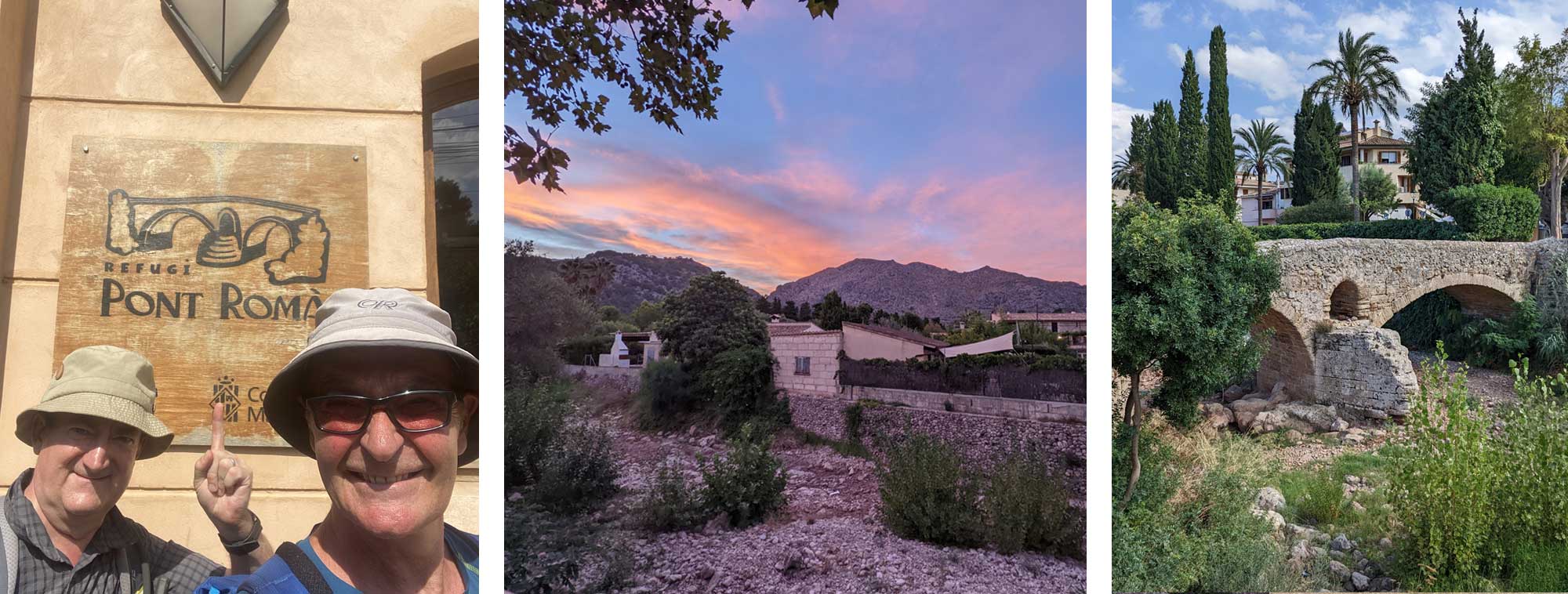
Day 9 Pollenca to Palma - by bus
The following day we got the bus back to Palma and spent a relaxed day exploring the city before our evening flight home to the UK. The buses on Mallorca are an incredibly good value way to get around. It cost around £4 to get from Pollenca to Palma and a similar amount for the bus to the airport.
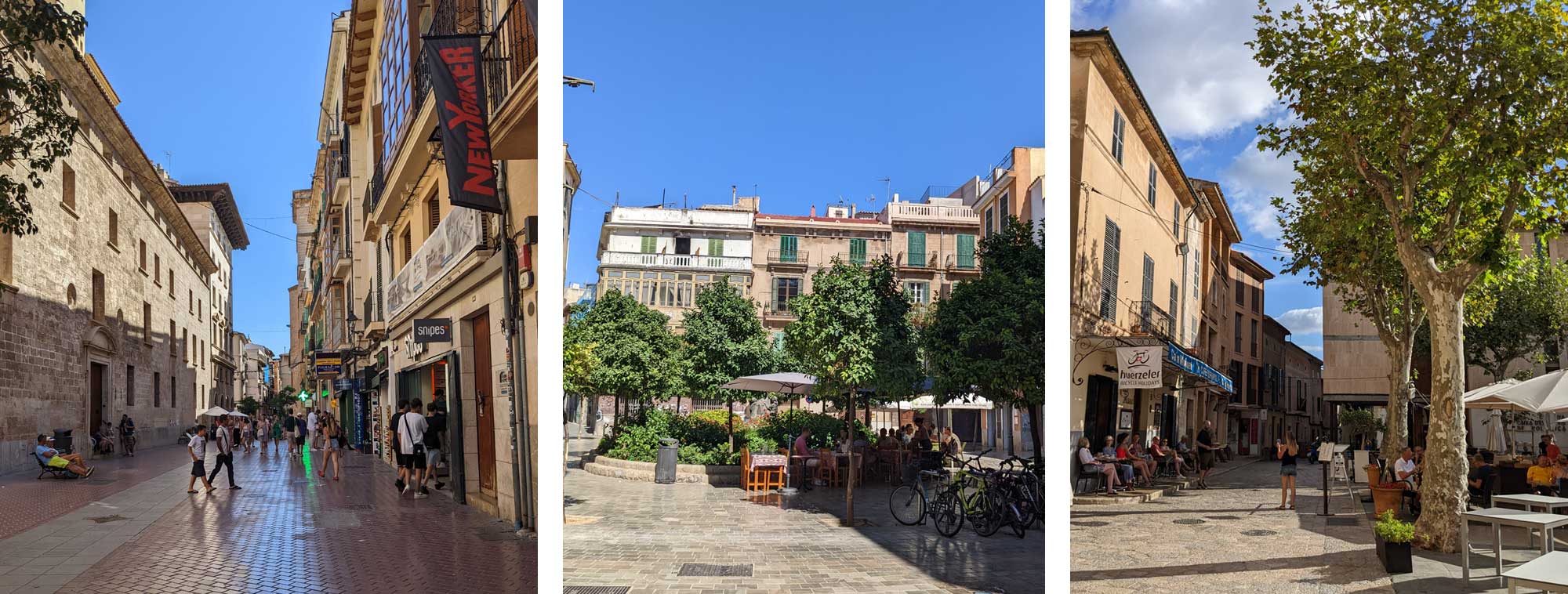
Heat Exhaustion and Heatstroke When Hiking and Backpacking
Whilst trekking the GR221, I suffered from heat exhaustion and the early stages of heatstroke. With the benefit of hindsight, I was showing the signs of severe heat exhaustion for some time before things went seriously downhill. Towards the end of the previous day, I had been struggling with the heat and wasn’t feeling too good. What I didn’t know was that heat exhaustion can build over multiple days.
On that day we had already climbed around 800m in extreme heat and were in a steep-sided limestone canyon that reflected the sun and funnelled the heat! I was displaying multiple symptoms of heat exhaustion but we simply didn’t realise until it was too late. Had we stopped and waited in the shade until I recovered then things would probably been very different. Instead, we were chasing the clock to get to our destination even though we had plenty of time.
I became progressively more unwell but was unaware of it until I ended up semiconscious, disoriented, unable to stand and hallucinating. It was an extremely serious situation which ultimately resulted in a helicopter rescue by the Guardia Civil made possible by carrying a Garmin Inreach Mini.
The Garmin enabled me to let someone know I was in big trouble. It seems a small investment to provide peace of mind and extra safety doing what we love.
Listen to what your body is telling you. I missed the signs and kept going when my body was telling me to stop, sit down and take a rest in the shade.
We were only stopping for a few minutes when it should have been until I had recovered. We kept walking in the heat of the day and should have waited until the day cooled. A big lesson but one I will remember and thought it was worth sharing so that hopefully other people can benefit.
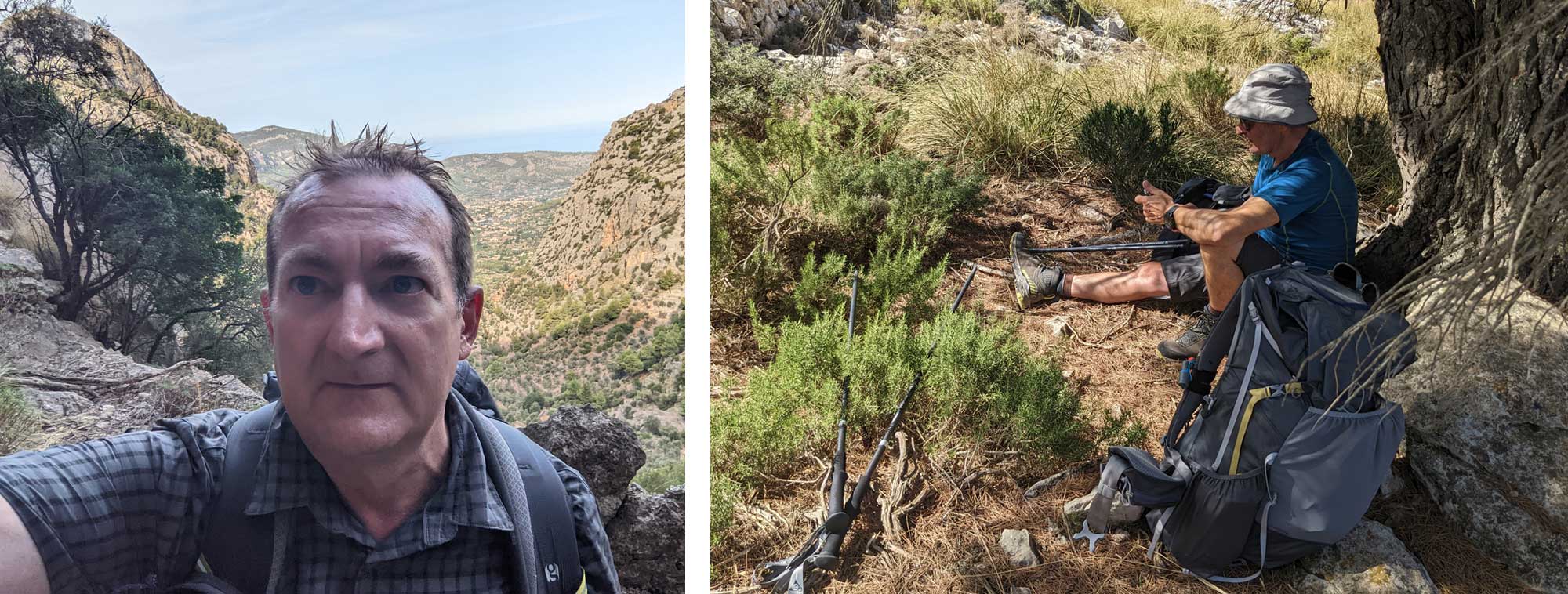
Here are some key signs to look out for heat exhaustion and heat stroke –
Heat Exhaustion
This is caused by the body overheating due to high temperature or exertion in hot weather. It is not as serious as heatstroke but heat exhaustion can develop into heatstroke which is a more serious and dangerous condition.
Symptoms and Signs for Heat Exhaustion
- Sweating heavily all over the body
- Feeling tired and weak
- Intense thirst
- Rapid pulse that weakens
- Feeling dizzy or lightheaded
- Nausea
- Headache
- Muscle cramps
- Moist or cold skin despite hot conditions
Heatstroke
Many of the symptoms are similar so it is difficult to tell when heat exhaustion becomes heatstroke.
- High fever, body temperature of 40°C plus
- Confusion
- Disorientated
- Slurred speech
- Delirium
- Headache
- Flushed red skin
- Change in sweating – skin can feel hot and dry
- Racing heart rate
- Rapid breathing
- Unconsciousness
- Nausea and vomiting
What to do if you or your walking partner show signs of heat exhaustion
- Get them to lie down in a cooler place – somewhere shaded from the sun.
- Remove excess clothing to allow as much skin as possible to be uncovered.
- Cool their skin with whatever you have available to you. Cool water or a wet cloth on their head and neck is perfect.
- Fan their skin, this will help to evaporate sweat or the water that you poured on which has a cooling effect.
- Drink plenty of fluids, ideally with electrolytes to replace lost salts.
- Avoid any further exertion until they cool down.
Hopefully, their condition should start to improve within a relatively short time – 30-60 minutes or so. Within an hour I had gone from hallucinating and being semiconscious to being able to think rationally again.
If there is no improvement then you will need emergency help.
If you suspect heatstroke then you should take the same action but call for help immediately. Heatstroke can be extremely serious and result in long-term damage to the brain, heart and kidneys and even death.
(Sources - NHS UK, Mayo Clinic, Red Cross, Centre for Disease Control and Prevention)

|
||
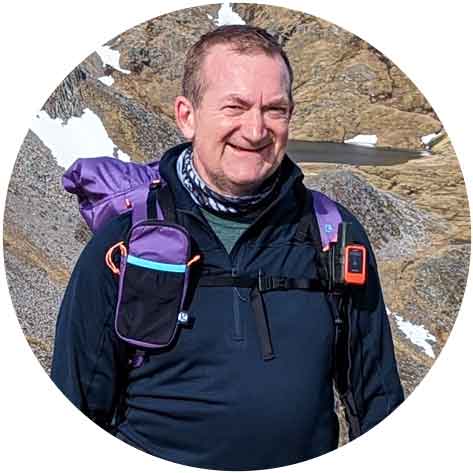 |
||
|
Danny Pearson |
||
|
Dan is a keen distance walker who loves to geek over the latest gear. In the last few years, Dan has completed a couple of TGO Challenge crossings of Scotland (with another planned for 2024), GR221 in Mallorca, Dales High Route and Hadrian’s Wall plus countless other self-planned routes. A keen mountain biker but finds he doesn’t bounce so well these days when the inevitable happens. |
||
